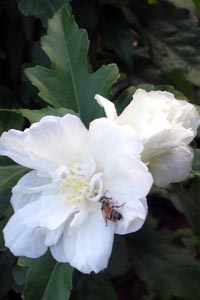 Hibiscus syriacus, Shrub Althaea, Rose of Sharon
Hibiscus syriacus, Shrub Althaea, Rose of Sharon
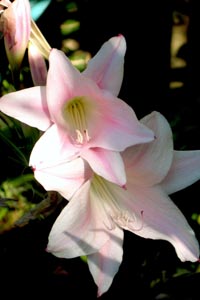 Pink Lily
Pink Lily
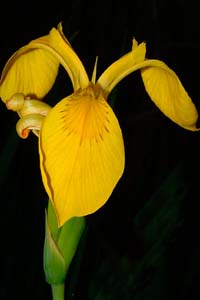 Iris pseudacorus
Iris pseudacorus
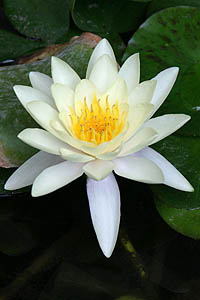 Nymphaea alba, White Water-Lily
Nymphaea alba, White Water-Lily
|
Rose of Sharon (Hebrew: "Chavatzelet HaSharon", חבצלת השרון)
"I am a rose of Sharon, a lily of the valleys.
As a lily among thorns, so is my love among the daughters".
Song of Songs 2:1-2
Three flowers are mentioned by name in the Bible: the SHOSHAN or SHOSHANNA (lily or rose), SHOSHANAT HA'EMAKIM (rose of the valleys) and HAVATZELET HA'SHARON (rose or lily of the Sharon).
It is impossible that the Havatzelet or the Shoshan was a rose, for the rose was not found in Israel in Biblical times. The rose of Sharon (Song 2:1) is a mistranslation: Havatzelet is an onion-like flower bulb.
Which one is likely to have been the "Havatzelet" from the Bible? What is the exact identity of the two flowers mentioned herein?
The Rose of Sharon, one name by different people for different plants: Hibiscus syriacus, Hypericum calycinum, Lilium candidum, Pancratium maritimum, Narcissus tazetta, Tulipa Montana and Tulipa sharonensis.
Some people think that Solomon's rose of Sharon is a tulip, either Tulipa montana, common in the mountainous regions of Syria and Lebanon, or its close relative, Tulipa sharonensis, found in sandy places on the Sharon coastal plain. Some have supposed the Narcissus tazetta, as the flower Solomon had in mind as Rose of Sharon.
Somebody in the horticultural world decided to name the Hibiscus syriacus, a deciduous flowering shrub native to east Asia, Rose of Sharon.
British and Australian English referred to Hypericum calycinum, an evergreen flowering shrub native to southeast Europe and southwest Asia as "Rose of Sharon".
It is also generally accepted that this flower is identified with the Pancratium maritimum -- a bulbous plant with white, highly scented flowers which blooms at the end of summer in the coastal lowland.
And others suggested that perhaps the Lilium candidum, known as the Madonna Lily, may be the "lily" referred to in Song of Songs 6:2:
My beloved is gone down to his garden,
to the beds of spices,
to feed in the gardens,
and to gather lilies.
According to the Brockhaus Encyclopedia, the lilium of the Old Testament is none other than the Iris pseudacorus.
According to Othmar Keel (Fribourg, Switzerland), The Song of Songs: a Continental commentary, page 78:
'The Hebrew word שושנה or שושן (shoshana or shoshan) is borrowed from Egypt, where it clearly means the water lily or lotus...
The Bible reports that the brim of the molten sea took the shape of the Shoshan (I Kings 7:26). Vessels in the form of lotus blossoms are known both on Egypt and in Israel but there are none in the form of lilies. One also reads of capitals in 'shoshan' form (I Kings 7:19,22). All kinds of lotus capitals have been found, but no lily capitals...Translators of the Hebrew Bible into Greek rendered שושנה, shoshana with κρίνον (lily).'
In Egyptian mythology the water lily represents the transfotmation from the dark ancient waters to the ordered world.
The lily was symbolic of rebirth after death. The Egyptians looked forward to their souls coming to life “like a water lily reopening”, thinking that the deceased died as the water lily closed awaiting opening with the morning sun.
The lotus of the ancient Egyptians was a true waterlily, today it is applied to Nelubium speciosum Willd., a native of eastern Asia and the East Indies.
It was an important model in art, e.g. the inspiration of Ionic capitals (an echinus based on a water lily shape.), the Greek fret or meander.
In Homer's Odyssey a mythical nation is described where the people subsist entirely on the lotus.
Homer (9th or 8th century BCE)- The Odyssey, (Translated by Samuel Butler 1900), Book IX
…"I was driven thence by foul winds for a space of nine days upon the sea, but on the tenth day we reached the land of the Lotus-eaters, who live on a food that comes from a kind of flower. Here we landed to take in fresh water, and our crews got their mid-day meal on the shore near the ships. When they had eaten and drunk I sent two of my company to see what manner of men the people of the place might be, and they had a third man under them. They started at once, and went about among the Lotus-eaters, who did them no hurt, but gave them to eat of the lotus, which was so delicious that those who ate of it left off caring about home, and did not even want to go back and say what had happened to them, but were for staying and munching lotus with the Lotus-eaters without thinking further of their return; nevertheless, though they wept bitterly I forced them back to the ships and made them fast under the benches. Then I told the rest to go on board at once, lest any of them should taste of the lotus and leave off wanting to get home, so they took their places and smote the grey sea with their oars…"
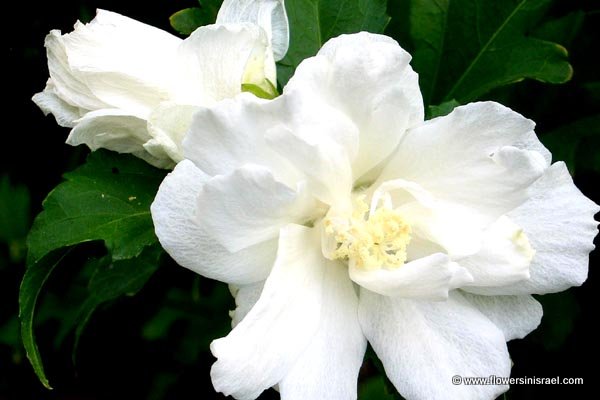 What are you "Rose of Sharon"?
What are you "Rose of Sharon"?
|
|
 Hibiscus syriacus, Shrub Althaea, Rose of Sharon
Hibiscus syriacus, Shrub Althaea, Rose of Sharon
 Pink Lily
Pink Lily
 Iris pseudacorus
Iris pseudacorus
 Nymphaea alba, White Water-Lily
Nymphaea alba, White Water-Lily